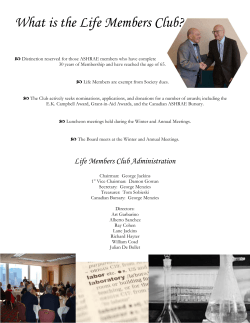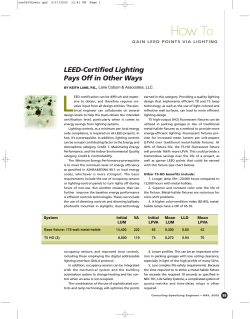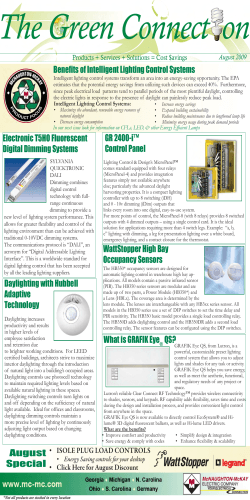
November 2004 Example LEED-NC v2.1 Energy & Atmosphere Credit 1 Submittal
Example LEED-NC v2.1 Energy & Atmosphere Credit 1 Submittal November 2004 The following documentation provides an example submittal for the LEED-NC v2.1 Energy & Atmosphere Credit 1 (EAc1). This sample EAc1 submittal includes the following elements: 1. Signed LEED Letter Template (Pg 2). 2. Summary statement, as requested in the LEED reference guide, presenting the energy efficiency measures incorporated in the building design. The summary includes both a narrative and a description of energy simulation inputs as follows: a. A narrative describing building systems (i.e. type of HVAC, lighting, hot water, etc.), and listing the major energy efficiency measures (Pg 3-4); b. A table presenting major energy simulation inputs for both the ECB and DEC (Pg 5-6); 3. Output from the energy simulation package demonstrating that the Design Energy Cost is lower than the Energy Cost Budget as defined in ASHRAE 90.1-1999, Section 11. The output presents all the information requested by the ASHRAE/IESNA 90.1-1999, Section 11 ECB. This requirement is most effectively satisfied by submitting the following: a. A narrative description of major discrepancies between the budget and design energy case pertaining to number of warnings, and percentage of hours any zone is outside of the throttling range (Pg 6) b. Page 1 of the Energy Cost Budget Compliance Report from the ASHRAE 90.11999 User’s Manual (Pg 7) c. A LEED energy summary by end use based on the “EAp2, EAc1 & EAc2” sheet of the LEED calculator (Pg 8). For this example submittal, a hypothetical building with the many common energy efficiency measures was simulated to elucidate nuances in the LEED-NC v2.1 EAc1 calculation protocol. The design and location were assembled to be representative of an EAc1 submittal that covers many of the energy simulation topics project teams may encounter in pursuing LEED-NC v2.1 EAc1. This example documentation was prepared by CTG Energetics, Inc. for the U.S. Green Building Council. Example LEED-NC v2.1 EAc1 Submittal November 2004 Pg 1 Example LEED-NC v2.1 EAc1 Submittal November 2004 Pg 2 Jamieson Academic Building LEED-NC v2.1 EAc1 A. Project Narrative: The new Jamieson Academic Building performs 44 % better than ASHRAE 90.1-1999 requirements using the LEED Energy Cost Budget methodology. This earns 6 LEED points. The Jamieson Academic Building consists of two structures connected by a central stairwell. The first structure is a thee-story, 68,000 square foot classroom building; the second structure is a three-story 22,000 faculty office building. The office building is mostly steel- frame construction. The west wall of the office building, and the entire classroom building are concrete construction. Three built- up VAV air handling units with chilled water provided from the campus central plant provide cooling and ventilation to the buildings; heating is provided through VAV reheat coils in each zone supplied by a central boiler. Lighting consists mostly of direct/indirect pendant mounted fluorescent fixtures in offices and classrooms, and compact fluorescent fixtures in hallways and other support spaces. Both the budget and design energy cases were modeled in eQUEST (version 3.51), an energy simulation program, created by James J. Hirsch & Associates, which calculates the heating and cooling loads and the building energy usage for each hour of the year. Note to LEED Documentation Authors: Please indicate the software used to prepare the calculations. The energy rates used for both the budget and as-designed cases were based on local utility rates including the City of Burbank Public Service Department commercial rate for electricity and the Southern California Gas Company GN-10 rate for natural gas. Chilled water rates for both the standard and proposed case were $9.75/MBTU based on an assumed central plant energy usage (for chillers, cooling towers, and pumps) of 1.0 kW/ton, and an average electricity cost of $0.117/kWh. Note to LEED Documentation Authors: If local utility rates are used, these should be referenced as shown above. If the Commercial Sector Average Energy Rates by State from the LEED Reference Guide are used, this should be stated clearly in the project documentation. The analysis was based on U.S. climatic data for Burbank / Hollywood (Table D-1 of ASHRAE 90.1-1999), and the building envelope requirements prescribed in Table B-6 of ASHRAE 90.11999. The TMY2 weather file for Burbank, CA (burbanca.bin) was used for the analysis. Note to LEED Documentation Authors: Please indicate the climate zone used for the analysis. B. Building Energy Efficiency Measures: 1. High Efficiency Lighting: Average lighting power density for the office structure is 0.805 W/sf versus 1.3 W/sf allowed by ASHRAE 90.1-1999 using the Building Area Method for offices. Average lighting power density for the classroom building is 0.93 W/sf versus 1.5 W/sf allowed by ASHRAE 90.1-1999. Example LEED-NC v2.1 EAc1 Submittal November 2004 Pg 3 2. Lighting occupant sensor controls: The private offices (offices less than 250 square feet) in the office structure use lighting occupant sensor controls to switch off the lighting whenever the offices are unoccupied. A credit interpretation request for EAc1 submitted 12/2/2003, and ruled upon 2/4/2003 states that it may be possible to arrive at a reasonable estimate for lighting occupant sensor controls by manipulating the lighting power densities in the proposed case. This project has adopted a 20% lighting power density credit for occupant sensor controls in private offices. By applying this modeling methodology, occupant sensor control credits in the office building reduce the lighting power density from 0.805 W/sf to 0.739 W/sf. 3. Daylighting controls: one half of the fixtures in the classroom building are controlled with photosensors and continuously dimmable ballasts. 4. Additional Insulation: The U- value for mass walls on the two structures is 0.074 versus 0.580 allowed by ASHRAE 90.1-1999. This is accomplished by adding rigid R-10 insulation on the interior surface of the mass wall. 5. High Efficiency Glazing: The assembly U-value for the fenestration ranges from 0.42 to 0.60 versus 1.22 allowed by ASHRAE 90.1. 6. Variable Speed Drives on fans smaller than 25 hp. Fans smaller than 25 horsepower have variable speed drives in the design energy case, but per ASHRAE 90.1-1999, they are modeled as forward curve centrifugal fans with inlet guide vanes. 7. Variable Speed Drives on Chilled Water and Hot Water pumps – the chilled water and hot water pumps serving the buildings are controlled by variable speed drives, rather than single speed pumps required by ASHRAE 90.1-1999 8. Photovoltaics: A 35 kW (rated DC power) photovoltaic system is installed on the building, producing an average 45,075 kWh of energy (AC output) annually. This number was calculated using eQUEST’s solar photovoltaics calculation after inputting the properties of the photovoltaics modules and the two inverters. Note to LEED Documentation Authors: Energy efficiency measures such as demand control ventilation that must be modeled using the exceptional calculation method (ASHRAE 90.1-1999, section 11.5) should be reported similarly to renewable energy. See the row titled “Renewable Photovoltaics (REC)” in the Energy Summary By End Use table on Page 8 for an example. C. Description of Differences Between ECB and DEC Case The Design Energy Cost case had one software warning, and the Energy Cost Budget case had 4 software warnings. All of these warnings state that a certain zone : • “has insufficient ZONE HEATING-CAPACITY plus BASEBOARD-RATING to maintain the specified DESIGN-HEAT-T for the calculated peak ZONE load.” The worst-case zone in the budget case is a North classroom. This zone is under-heated 40 hours out of the year in the Energy Cost Budget case and 0 hours per year in the Design Energy Cost case. This is within the 50 hour per year limit required by ASHRAE 90.1-1999. Example LEED-NC v2.1 EAc1 Submittal November 2004 Pg 4 D. Comparison of Budget Design versus Design Energy Case Building Element: Building Design ASHRAE 90.1-1999 Prescriptive Requirement (Energy Cost Budget case) (Design Energy Cost case) BUILDING ENVELOPE Wall • Office (most): R-21 Steel-frame wall, • Office (most): R-13 Steel-frame wall, Construction U-factor = 0.097 U-factor = 0.124 • Office (west): 8” concrete furred out with • Office (west): Mass Wall, metal furring and R-21 batt insulation; U-factor = 0.580 U-factor = 0.074 • Classrooms: Mass Wall, U-factor = 0.580 • Classrooms: 8” concrete furred out with metal furring and R-21 batt insulation, U-factor = 0.074 Opaque Doors • Hollow Metal Door, U-factor = 0.580 • U-factor = 0.700 Windows • 21% window-to-wall ratio (including • 21% window-to-wall ratio (including glass doors) glass doors) • Metal Frame, Double-Pane low-E glass (some fritted) • U-value = 1.22 • U-value = 0.42 to 0.60 • SHGC = 0.25 (Non-North) • SHGC = 0.40 to 0.44 • SHGC = 0.61 (North) Floor Uninsulated 6” concrete Slab-on-Grade • Uninsulated 6” concrete Slab-on-Grade F-0.730 • F-0.730 Roof • R-21 built-up roof, U-factor = 0.043 • R-15 built up roof, U-factor = 0.063 ELECTRICAL SYSTEMS Lighting Power • Office Structure: 0.805 W/sf average • Office Structure: 1.3 W/sf Density • Classroom Structure: 0.93 W/sf average • Classroom Structure: 1.5 W/sf Lighting • Occupant sensor controls in private • No occupant sensor controls Occupant offices; modeled as 20% reduction in Sensor lighting power density; results in LPD for Controls the office building of 0.739 W/sf. Lighting • Daylighting controls (photo sensors and • None Daylighting dimmable ballasts) for 50% of fixtures in Controls classrooms. Equipment • 1.5 W/sf in offices • 1.5 W/sf in offices Power Density* • 1.0 W/sf in classrooms & labs • 1.0 W/sf in classrooms & labs Exterior • 3.1 kW controlled via photocell (on from • 3.1 kW controlled via photocell (on from lighting* dusk to dawn) dusk to dawn) RENEWABLE ENERGY SYSTEMS Photovoltaics • 35 kW (DC) at a 5 deg. tilt, oriented • None South. • Inverter efficiency = 84%. Note to LEED Documentation Authors: Always include a description of renewable energy systems used to reduce design energy cost. SCHEDULES Occupancy, • Monday through Friday 8AM to 7PM, • Monday through Friday 8AM to 7PM, Lighting & Saturday 8AM to 2PM Saturday 8AM to 2PM Equipment HVAC • Monday through Friday 6AM to 7PM, • Monday through Friday 6AM to 7PM, Saturday 6AM to 2PM Saturday 6AM to 2PM * Note: Unregulated loads Example LEED-NC v2.1 EAc1 Submittal November 2004 Pg 5 D. Comparison of Budget Design versus Design Energy Case (Continued) Building Element: Building Design (Design Energy Cost case) MECHANICAL & PLUMBING SYSTEMS HVAC System • AHU-1, AHU-2 (classrooms), and AHUType 3 (offices) are VAV with HW reheat. • FCU- 1, 2, and 3 (telecommunications rooms) are 4-pipe fan coils. • Chilled water for AHUs and FCUs provided by a remote central plant (modeled as a CHW meter). • Heating hot water for all AHUS and FCUs is provided by a boiler in the building. Air-Side • Enthalpy-based air-side economizers for Economizer AHU-1, AHU-2, AHU-3. Controls AHU Fan All AHUs: Properties • 3” total fan static pressure • Mechanical efficiency: 72% AHU-1 (Office) & AHU-2 (Flr 1 Classroom): • Motor Efficiency: 93% • Variable Speed Drive (Drive Efficiency: 97%) • Supply Air Flow: 20,000 cfm Boiler Efficiency Central Plant Efficiency AHU-3 (Flr 2&3 – Classroom Structure): • Motor Efficiency: 93.6% • Variable Speed Drive (Drive Efficiency: 97%) • Supply Air Flow: 40,000 cfm • 80% • Not Applicable since CHW is provided from the campus plant ASHRAE 90.1-1999 Prescriptive Requirement (Energy Cost Budget case) • Same as Design Energy Case per Figure 11.4.3 and Table 11.4.3a in ASHRAE 90.1-1999. System types selected from Table 11.4.3a include: • System 4: AHU-1, AHU-2 & AHU-3 • System 7: FCU-1,2, and 3 • Air-side economizer not required. • Ventilation rate is constant All AHUs: • 3” total fan static pressure • Mechanical efficiency: 72% AHU-1 (Office) & AHU-2 (Flr 1 Classroom): • Motor Efficiency: 91.0% • Forward-curve fan with inlet vanes • Supply Air Flow: 20,000 cfm AHU-3 (Flr 2&3 – Classroom Structure): • Motor Efficiency: 92.4% • Variable Speed Drive (Drive Efficiency: 97%) • Supply Air Flow: 40,000 cfm • 80% • Not Applicable since CHW is provided from the campus plant Note to LEED Documentation Authors: Central plant efficiencies and capacities for chillers and cooling towers should be listed whenever the central plant is included as part of the energy model HVAC • Same as ASHRAE 90.1-1999 • Chilled water loop is constant flow Circulation prescriptive requirements except that • CHW Pump Head: 50 feet Loop both the CHW and HHW pumps have • CHW Pump Efficiency: 70.6% Properties variable speed drives and both chilled (motor + impellar) and hot water loops are variable flow. • Hot water loop is a constant flow • HW Pump Head: 60 feet • HW Pump Efficiency: 65.8% (motor + impellar) Domestic • One 100-gallon natural gas storage • One 100-gallon natural gas storage Water Heating water heater with 80% thermal water heater with 80% thermal efficiency efficiency Example LEED-NC v2.1 EAc1 Submittal November 2004 Pg 6 Energy Cost Budget (ECB) Compliance Report Page 1 Project Name: Jamieson Academic Building Project Address: 1612 Overture Dr. Date: Designer of Record: Dr. Van Nostrand Telephone: 818-498-2172 Contact Person: A. Vandalay Telephone: 818-239-4294 City: Burbank, CA Principal Heating Source: Weather Data: Burbank CA (Burbanca.bin) Energy Code: October 5, 2004 Electricity x Fossil Fuel Solar/Site Recovered Other ASHRAE 90.1 1999 Space Summary Conditioned Area (sf) 50,500 Building Use 1. Classroom Unconditioned (sf) Total (sf) 50,500 2. Storage 3,000 3,000 3. Restroom 2,000 2,000 4. Office 15,000 15,000 5. Corridor 12,500 12,500 2,000 2,000 6. Conference 7. Mechanical/Electrical 2,000 2,000 8. Indoor Stairwell 2,000 2,000 4,000 89,000 Total Advisory Messages Proposed Building Design Difference (Proposed Budget) Budget Building Percent of hours sytem load out of throttling range 0.0% 1.0% 1.0% Percent of hours plant load not met 0.0% 0.0% 0.0% Number of warnings 0 0 0 Number of errors 0 0 0 Number of defaults overridden 1 4 3 Description of differences between the budget building and proposed design not documented on other forms: Not Applicable x Attached Compliance Result The design detailed in the above referenced plans complies with the mandatory requirements of ASHRAE 90.1 1999 and the design energy cost does not exceed the Energy Cost Budget. Therefore, this design DOES COMPLY with the ASHRAE 90.1 1999 ECB Compliance Methodology. Individual certifying authenticity of this data provided in this analysis: Signature: CTG Energetics, Inc. ASHRAE 90 1-1999 LEED ECB editable.xls Title: Mechanical Engineer 12/6/2004 11:39 AM Regulated? Energy Summary by End Use End Use Lighting - Conditioned Proposed Building Budget Building Optimized Energy Performance Energy Type Energy 3 [10 Btu] Peak Energy 3 3 [10 Btu/h] [10 Btu] Peak 3 [10 Btu/h] [%] x Electricity 524,326 200 1,194,349 375 44% Space Heating x Natural Gas 641,200 1,345 646,400 1,498 99% Space Cooling x Chilled Water 2,150,000 2,763 2,576,000 3,146 83% Pumps x Electricity 26,690 26 47,458 35 56% x Electricity 92,820 45 162,899 87 57% x Natural Gas 608,100 51 608,100 51 100% Office Equipment Electricity 418,239 127 418,239 127 100% Exterior Lighting Electricity 73,420 11 73,420 11 100% Lighting - Unconditioned Heat Rejection Fans - Interior Ventilation Fans - Interior Exhaust Fans - Parking Garage Service Water Heating TOTAL BUILDING CONSUMPTION 4,534,795 5,726,865.2 TOTAL REGULATED BUILDING CONSUMPTION 4,043,135 5,235,205 79% Note: Energy Consumption is listed in units of site energy 3 3 10 Btu = kWh x 3.413 10 Btu = therms / 100 Energy and Cost Summary by Fuel Type DEC Use DEC Cost 3 Type [10 Btu] [$] NONRENEWABLE (REGULATED + UNREGULATED) Electricity (Total) Natural Gas (Total) Chilled Water (Total) Total Nonrenewable (Regulated + Unregulated) 1,135,495 $ 1,249,300 $ 2,150,000 $ 4,534,795 39,347 7,664 1,896,365 2,576,000 $67,975 5,726,865 DEC' Cost [$] Electricity (Total) ECB Cost [$] $ 1,254,500 $ 20,964 DEC' Use 3 Type [10 Btu] NONRENEWABLE (REGULATED ONLY) 643,835 ECB Use 3 [10 Btu] ECB' Use 3 [10 Btu] $ DEC / ECB Energy % Cost % 65,342 60% 60% 7,694 100% 100% 25,118 83% 83% $98,154 79% 69% ECB' Cost [$] DEC' / ECB' Energy % Cost % $ 22,310 1,404,705 $ 48,401 46% 46% Natural Gas (Total) 1,249,300 $ 7,664 1,254,500 $ 7,694 100% 100% Chilled Water (Total) Total Nonrenewable (Regulated Only) 2,150,000 $ 20,964 2,576,000 $ 25,118 83% 83% $81,213 77% 63% 4,043,135 DEC'' Type Renewable Photovoltaics (REC) Total including Renewable Use 3 [10 Btu] $50,938 DEC'' Cost [$] (153,841) $ 3,889,294 Example LEED-NC v2.1 EAc1 Submittal November 2004 5,235,205 $ DEC' / ECB' Energy % Cost % (5,331) - - 74% 56% Percent Savings = (ECB' $ -DEC'' $)/ECB' $ = 44% Percent Renewable = REC $/DEC' $ = 10% 45,607 5,235,205 $ 81,213 Pg 8
© Copyright 2026












